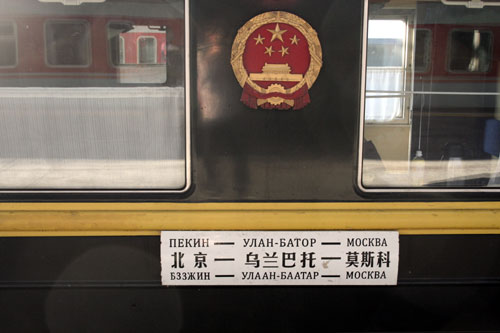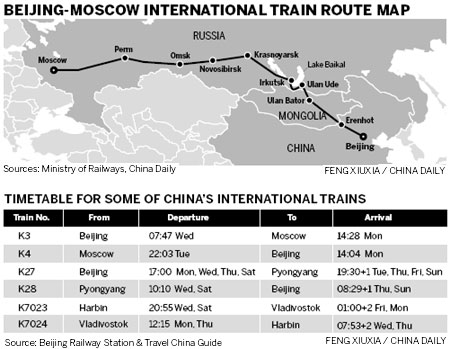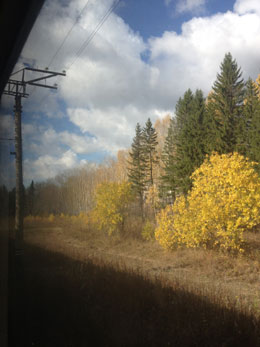Romance of the Beijing-Moscow line
Updated: 2012-11-01 07:58
By Qin Zhongwei (China Daily)
|
|||||||||||
|
 The outside of one of the green carriages on the K3 train, which runs from Beijing to Moscow via Ulan Bator. The route began on May 24, 1960. Provided to China Daily |

New trains may rekindle interest in riding the rails
As Wang Hairuo, a 25-year-old Beijing resident, waited for the train on the morning of Sept 26, he felt like Harry Potter standing on platform 9 3/4 at King's Cross Station, expecting the train to Hogwarts.
Different from his previous trips, his impending travel from Beijing Railway Station made him feel that his own magic journey was about to start. It would take him all the way to Moscow, passing through five time zones and 80 degrees of longitude. The duration of the one-way trip - six days and five nights - set a new record for his longest trip ever by train.
"It was just amazing!" he said, after arriving back from Moscow. He posted photos on Sina Weibo, China's answer to Twitter, where he shared his reaction to the 7,628-km train ride with friends.
China operates a number of international train routes across its border, connecting it with neighboring countries and beyond. Among them, the K3/4 train running between Beijing and Moscow (K3 from Beijing to Moscow, and K4 from Moscow to Beijing) has been operating for more than 50 years. It was the country's first international train route, and it remains perhaps China's most famous international rail journey.
 |
|
A Siberian forest viewed from the train. [Provided to China Daily] |
Beginning on May 24, 1960, the K3 train departed for the first time from Beijing to Moscow via Ulan Bator and wild Siberia. Over the past 52 years, the train has run once a week all year round. It did not stop, even for a day, when ties between China and the former Soviet Union worsened and frayed in the 1960s, according to Gao Jun, head of the international transportation team at Beijing Railway Station, which operates the train.
In 1956, railway ministers from 12 major countries in Eastern Europe and Asia established the Organization for Cooperation of Railways, to improve the coordination of rail transportation. As the equivalent of the International Union of Railways established by Western European countries, the organization has helped develop railway transportation among its member countries.
As one member country, China started to run its train routes with neighboring countries. Over the past five decades, the Beijing-Moscow route has transported more than 1.4 million people from about 100 countries.
"It used to be one of the most well-known ways for Western travelers to reach China and the Far East," Gao said, adding that diplomats, foreign students and officials on business trips abroad made up the majority of passengers at the very beginning.
More convenient trip
Wang is probably among the last group of travelers to take the train that was put into use in 1996. Soon it will be upgraded by a new generation of trains offering a more convenient ride, according to Gao. He said the second round of test rides on the new train has just been completed, and the official launch has been provisionally arranged for November.
The new train was made in China and will replace the current German-made train on the route, according to Liu Yonggang, chief designer of the new train from Qingdao-based CSR Sifang Corporation, a native train producer.
Compartments in the current train are still heated by burning coals, but the new train will use electricity to heat compartments, and the temperature inside can be kept constant, Liu said.
Though still bearing its signature green color like most other Chinese passenger trains in the 1990s, facilities inside the new train will be much more comfortable. They will include an air-conditioning system for the first time, he said.
"The temperature inside can reach more than 40 C in summer, and in winter go as low as -50 C. You can imagine why we are so demanding about the technological improvements of the train," Gao said.
There will also be toilets and sleepers specially designed for disabled passengers, he said.
Today's Top News
President Xi confident in recovery from quake
H7N9 update: 104 cases, 21 deaths
Telecom workers restore links
Coal mine blast kills 18 in Jilin
Intl scholarship puts China on the map
More bird flu patients discharged
Gold loses sheen, but still a safe bet
US 'turns blind eye to human rights'
Hot Topics
Lunar probe , China growth forecasts, Emission rules get tougher, China seen through 'colored lens', International board,
Editor's Picks

|

|

|

|

|

|





